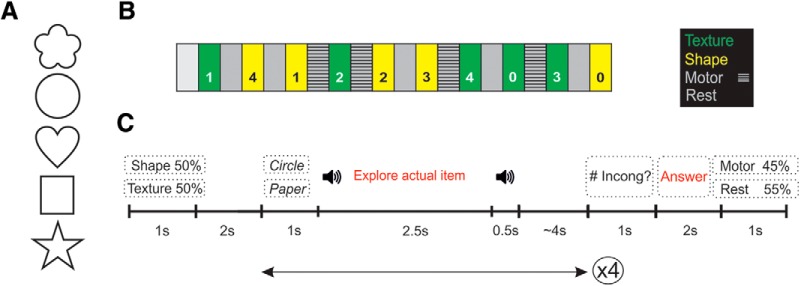Figure 2.
Stimuli and procedure used in the haptic discrimination task. A, Stimuli: variety of five shapes (flower, circle, heart, square, and star). The 25 haptic stimuli were manufactured covering each of the five shapes with five textures (corduroy, sandpaper, plastic, paper, and expanded polystyrene). B, Block design for one run. Each run comprised 10 haptic blocks (green-attend texture; yellow-attend shape) and began with a 10-s interval that was not analyzed. The order of the haptic blocks was randomized. Between two haptic blocks, rest or motor blocks were presented in randomized order. In each haptic block, four haptic trials where presented (see panel C for further information on haptic blocks). The number in each block corresponds to the number of incongruent trials presented in that block (ranging from a minimum of 0 to a maximum of 4). For a particular dimension (shape/texture), the number of incongruent trials within each block was not repeated in that run. C, Procedure for a haptic block. The block began with an auditory cue instructing as to the dimension of the object that had to be attended to (50% shape, 50% texture). After a 2-s interval, the first haptic trial started. In each haptic trial, the name of an expected item was presented and an auditory cue indicated that the exploration of the actual item could begin. In half of the trials, the word delivered by the headphones corresponded to the touched object (congruent), and in the other 50% of trials, the object did not match the name (incongruent). We therefore had six conditions [four corresponding to all the possible combinations: congruent shape (CSh), incongruent shape (ISh), congruent texture (CTx), and incongruent texture (ITx); and two additional control conditions: motor (M) and rest (R)]. Free exploration was allowed. 2.5 s later, a second auditory cue indicated that the exploration period was over. After a jittering period, the next haptic trial could start. After four haptic trials, the participants were asked about the number of incongruent trials. Using their left hand, participants had to push a button as many times as the incongruent trials that had been presented (ranging from 0 to 4). To conclude, an auditory cue indicated whether a rest or “motor” block followed (a block in which participants were asked to move the fingers as they were exploring an imaginary object).

